“If you see me on a train, ignore my dog”: How to treat service dogs and their handlers with respect on BART
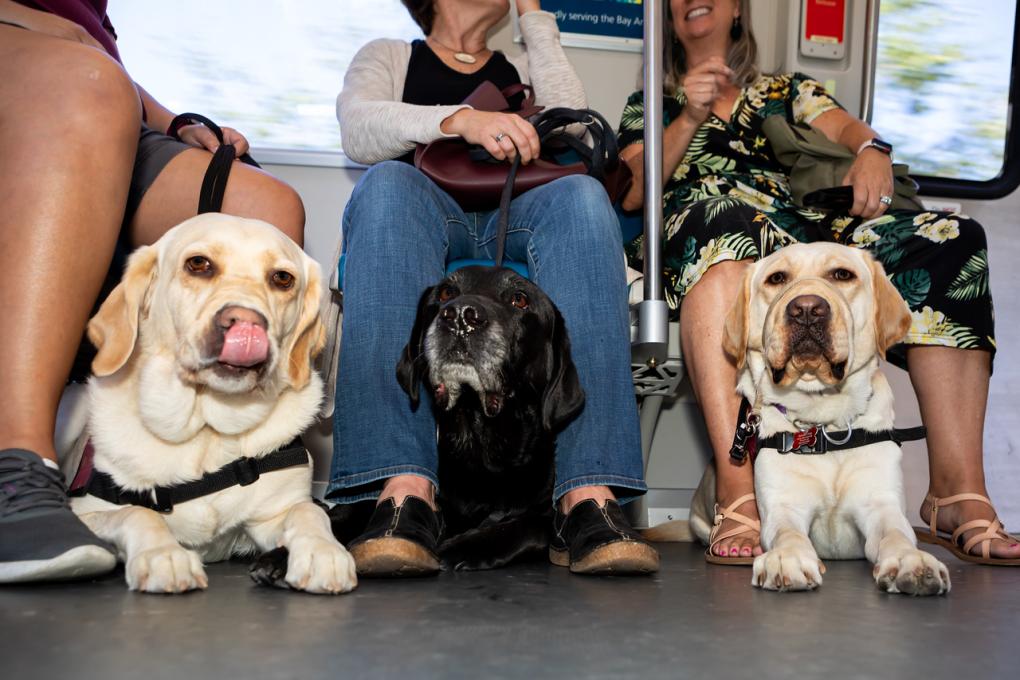
Early Alert Canines service dogs on BART, from left to right: Scarlett with handler Alysia Santos, Handsome Ransom with handler Kathleen Fraser, Sheldon with puppy trainer Suzie Scher.
See our DOs and DON’Ts for pets on BART below.
TLDR: You may only bring a pet onboard and in stations if it is secured in an enclosed carrier made for the transport of animals. Animals on leashes are prohibited with the exception of trained service dogs. Service dogs are allowed off leash if their owners are unable to hold a leash and the animal is under voice command of their owner. Please contact BART's Access and Accessibility Department for more information.
Service animals are defined by the American Disabilities Act as any guide dog, signal dog, or other animal individually trained to work or perform tasks for an individual with a disability. Emotional support animals are not service animals and must be in a carrier when on BART.
BART offers free BART rides for those training service animals on the system. Arrangements must be made with BART’s Customer Access Department beforehand.
Read more about our pets on BART rules at bart.gov/pets.
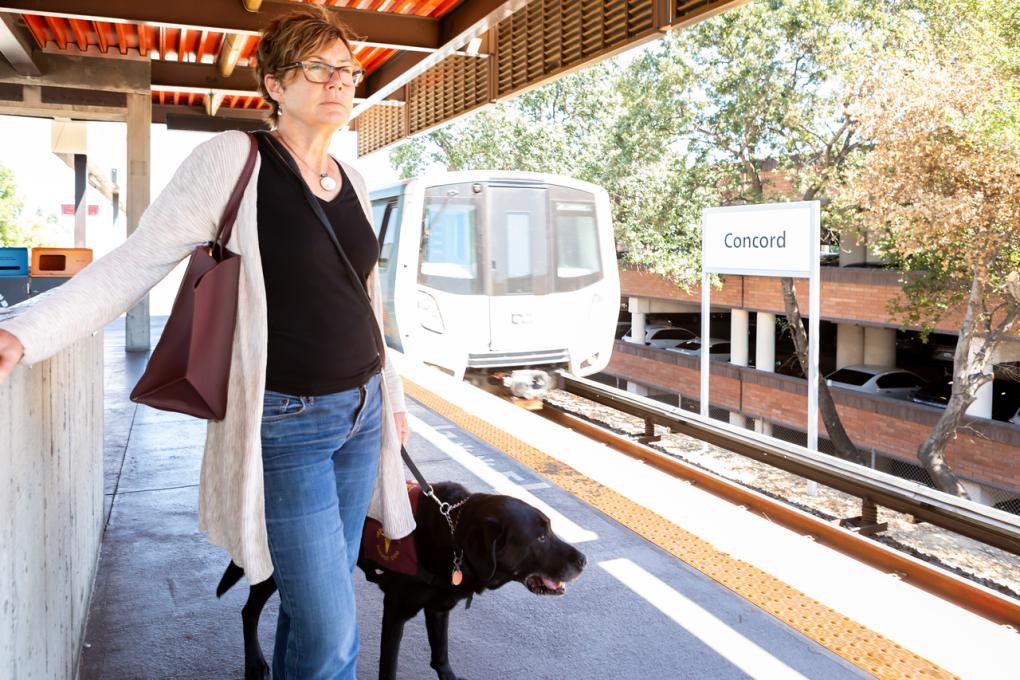
Kathleen Fraser and her service dog, Handsome Ransom, on the platform at Concord Station.
Dogs are cute. But some dogs have jobs to do, including when they’re riding BART.
Handsome Ransom is San Francisco resident Kathleen Fraser’s dog. He's got a big, goofy smile and soft black fur. Over that smooth coat, he wears a dark red vest with yellow embroidered text that reads: “Medical Alert Service Dog.”
Many of us see a dog out in the world and our brains scream, CUTE CUTE CUTE, MUST PET PET PET. Ransom, like all dogs, can be distracted however, and unlike all dogs, he’s specially trained to save his handler’s life.
“If you see me on a train, please ignore my dog,” Fraser said as a PSA to her fellow BART riders.
Fraser has type 1 diabetes, a lifelong condition where her pancreas doesn’t make any insulin, leading to high blood sugar levels. This can lead to a series of complications, including but not limited to nerve damage, heart attack, stroke, seizures, and in the most tragic cases, death.
In 2016 after a series of close calls, Fraser reached out to the Concord-based nonprofit Early Alert Canines in search of a service dog that would alert her when her blood sugar was dropping. The organization is one of a handful that trains medical alert dogs and connects them to people with type 1 diabetes.
Early Alert paired Fraser with Handsome Ransom, who quickly became her best friend and most steadfast companion. Wherever Fraser goes, Handsome Ransom comes too, including on BART rides. He has to; without Ransom by her side, Fraser's blood sugar could fall, and she might not even realize it. Ransom can detect blood sugar crashes sooner than any modern medical device and often before the person recognizes the signs of an oncoming drop, such as sweating, shakiness, dizziness, anxiety, intense fatigue, etc.
“Trained dogs pick up the scent of the chemicals your body releases when your blood sugar is dropping,” said Carol Edwards, the Executive Director of Early Alert Canines.
“As soon as they smell those particles, they go, ‘There it is!’ and they alert their handler with a simple lift of their paw,” Edwards said. When a dog gives the alert, their handler can pause, look at the number on their glucose monitor, “and make an informed decision on what to do next before they get to that low state where one of the first things to go is cognitive ability."
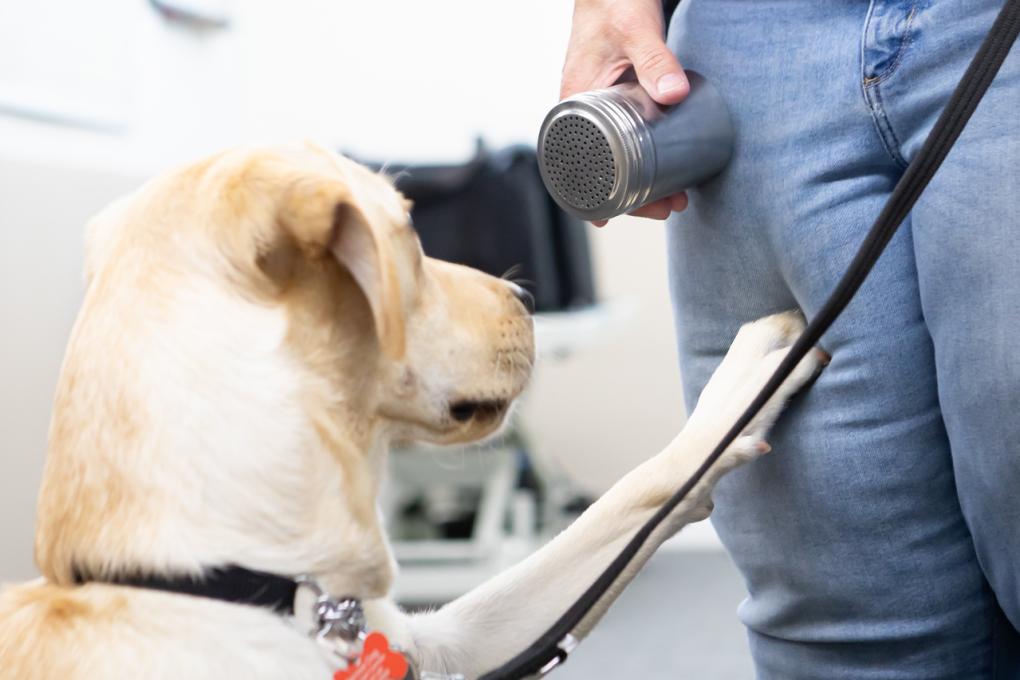
Service dog Scarlett correctly identifying a canister containing scent samples with a blood sugar level of 70mg/dL or lower at Early Alert Canines in Concord.
The dogs are scent trained for around six weeks using a 12-arm scent wheel, with each arm ending with a small canister with a perforated lid (think spice shaker). The scent samples within are collected from individuals with type 1 diabetes experiencing a blood sugar level of 70 mg/dL or lower. Once the dogs are familiar with searching the scent wheel, they undergo a series of 500 double-blind trials. In these trials, neither the trainer nor the dog knows which canister contains the target scent. In all, the process takes around six weeks.
Fraser said Ransom has alerted her thousands of times since they were first matched eight years ago. Sometimes, Ransom will give the alert more than a dozen times a day.
“What I wish people would realize is that service dogs provide medical support that is just as important as a wheelchair or a white cane or hearing aid," Fraser said. "Yes, they are adorable, and yes, we all want to go up and squish them and all of that. But when they're out, they’re in work mode, and they need to be attending to their person.”
Many don’t realize this because they just don’t know. And that’s exactly why Fraser is sharing her experiences, including some that are painful to remember.
Fraser used to take transit to work in San Francisco all the time. But things became too challenging – and terrifying – when fellow passengers would consistently scold her for bringing a dog on transit or for using a seat reserved for disabled people in the front. Fraser often uses one of these seats as a safety measure for the dog because sitting against a wall limits the chances of someone trampling or stepping on him, thereby preventing him from doing his job. If the dog gets distracted or injured, it puts Fraser’s safety at risk.
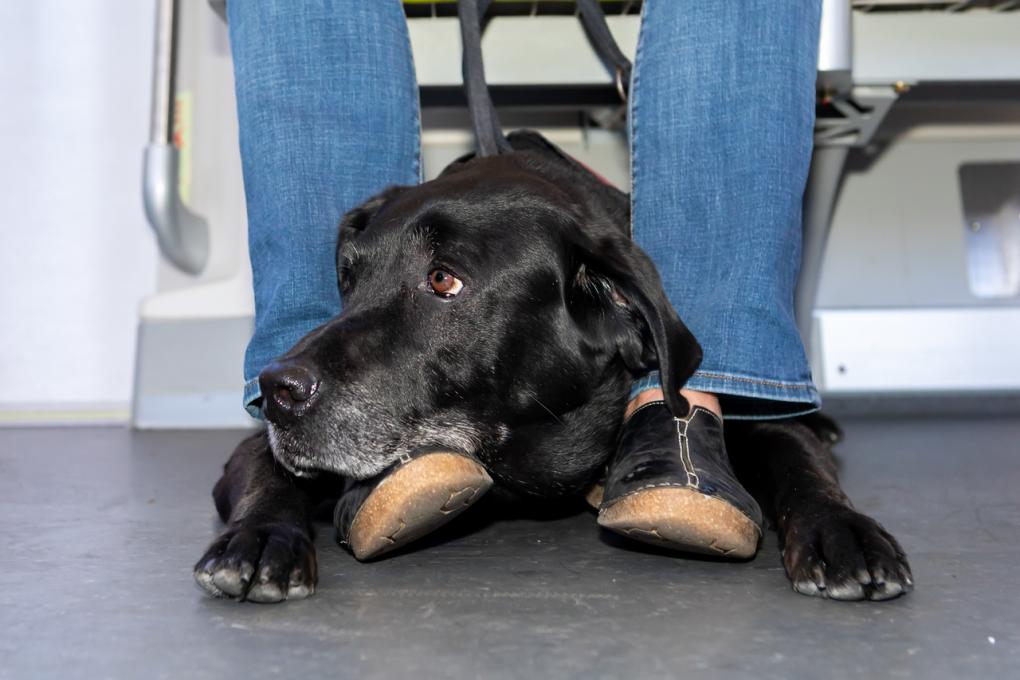
Handsome Ransom on BART between Kathleen Fraser’s legs in a seat against the wall.
"There have been many times where I'm sitting in one of the reserved seats and the public, for one reason or another, starts yelling at me about ‘How dare I sit in that seat, when XYZ person should have that seat,’” she said.
These encounters, on more than one occasion, spiraled into an “angry mob” situation, with people asking Fraser questions like: “What’s wrong with you? Why do you get to bring a dog on transit?”
“We live in a world now where there are many ‘fake’ service dogs,” Fraser said. “People are sensitive about it in San Francisco because we have strong laws around emotional support animals and renting apartments.”
"It's also complicated by the fact that my disability is somewhat invisible,” she added. “People say to me, ‘Well, you don’t look disabled,’ and I say, ‘What does disabled look like to you?’ Most people think ‘disabled’ refers to those with visible physical disabilities, but that’s not the case. And it’s caused me a heck of a lot of trouble.” According to multiple sources, the vast majority of disabilities are “invisible.”
Type 1 diabetes is a protected class under the Americans with Disabilities Act (ADA), which prohibits discrimination against those with disabilities in all areas of public life, including transportation. ADA defines service animals as any guide dog, signal dog, or other animal individually trained to work or perform tasks for an individual with a disability.
Dogs whose sole functions are to provide comfort or emotional support do not qualify as service animals under the ADA, and Fraser wants to be very clear: Ransom's job is not providing emotional support. That's an added bonus. People with diabetes are two to three times more likely to have depression than those without diabetes, and “having a dog who loves you unconditionally helps with that,” Fraser said.
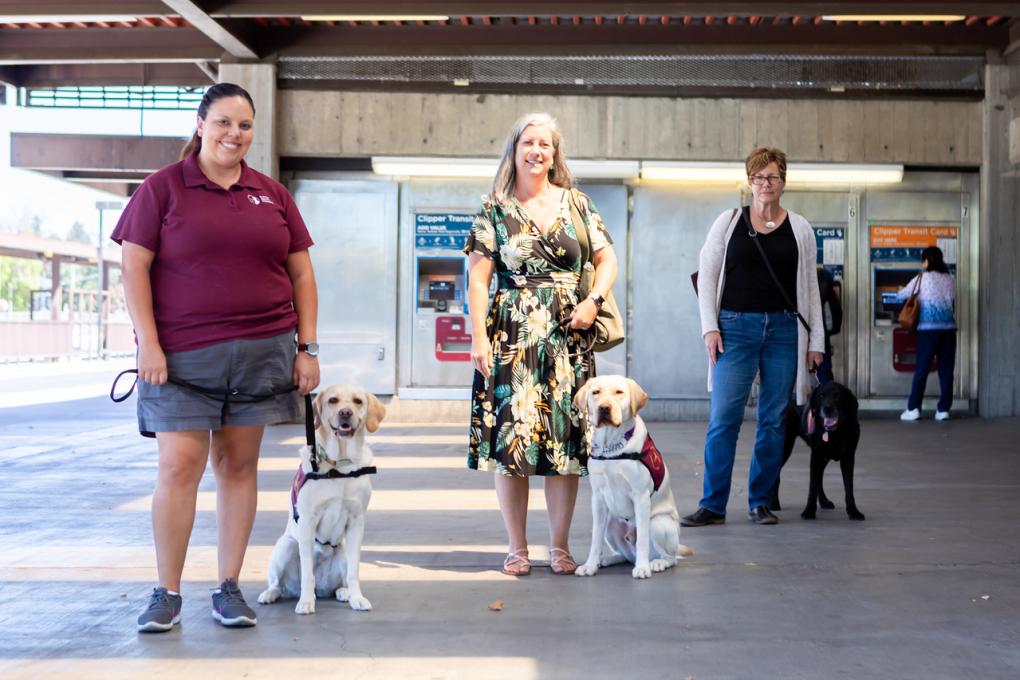
From left to right: Scarlett with handler Alysia Santos, Sheldon with handler Suzie Scher, Handsome Ransom with handler Kathleen Fraser. Pictured in the unpaid area of Concord Station.
When you encounter a person with a service dog, there are two questions you can ask. One, is the dog a service animal required because of a disability? And two, what work or task has the animal been trained to perform? People with service dogs do not have to disclose their disability.
Because of her traumatic experiences, Fraser no longer takes transit, instead opting to drive three miles to her office and pay for an expensive parking spot. Sometimes, that’s the way it is when you’re maneuvering around a world that is not designed with a diverse spectrum of disabilities in mind.
"This disability is vicious, it's volatile, it's unforgiving, it's cruel, and completely unpredictable,” Fraser said of type 1 diabetes. "There is research that says people with type 1 diabetes have to make 300 additional decisions a day just to stay alive.”
Early Alert Canines makes a point to train their dogs on public transportation because the animals’ future handlers may use it back home. 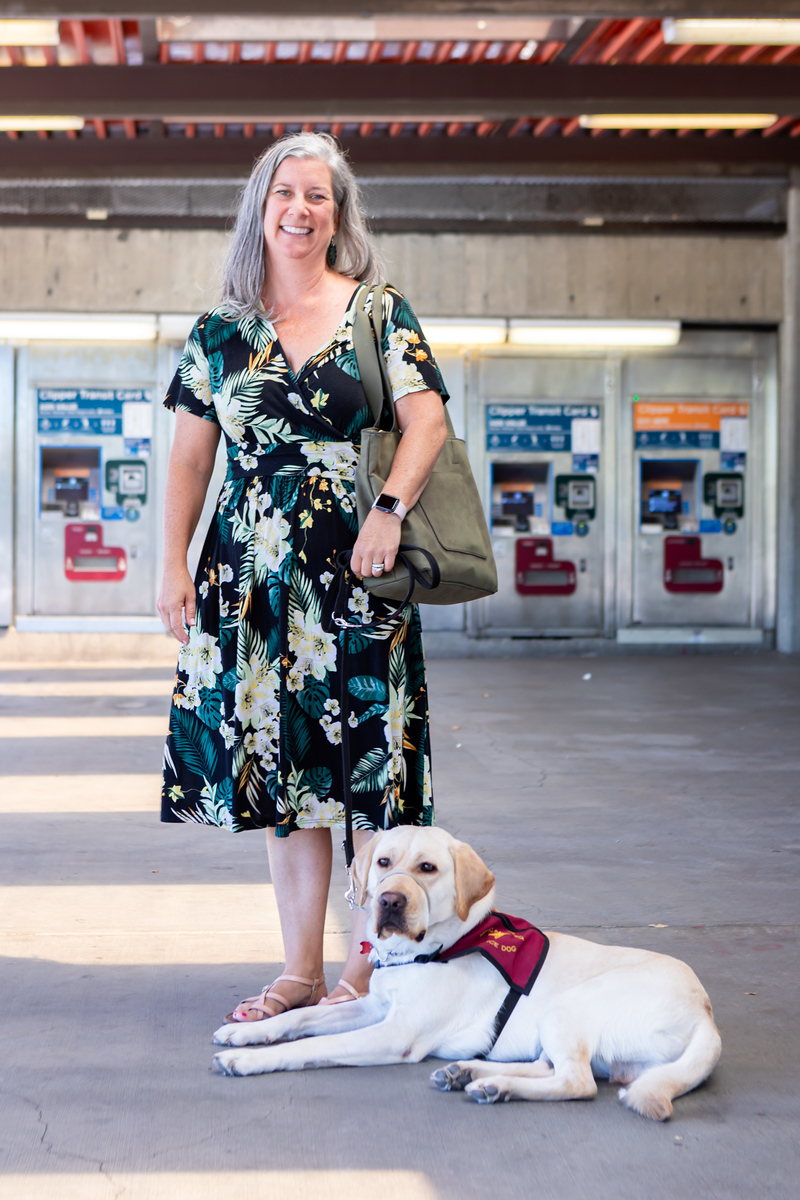
Suzie Scher (pictured on the right with Sheldon) is a volunteer puppy raiser, and she made sure her trainee pup, Sheldon, got some experience riding the trains. She recently took BART to Downtown Berkeley Station for a visit to the Ed Roberts Campus, a universally designed, transit-oriented campus that was created by disability organizations that share a common history in the Independent Living Movement of People with Disabilities.
“I wanted to make sure he's been on BART before he’s paired with his handler,” she said. “These dogs can be placed with people anywhere in the country – they could be riding the Chicago L or the New York subway, and they need to be prepared.”
There are many stimulants in a transit space – the click of the fare gates, the whoosh of a train pulling into the station – and puppy raisers like Scher ensure their dogs know what they’re getting into before they’re sent off to live with their owners.
Fraser said Ransom is a “champ on BART.” On a recent visit to Concord Station, Ransom serenely followed Fraser through the fare gate, walked up the stairs, and waited on the platform beside her until they got on a train. Onboard, Fraser found a seat against the wall, and Ransom deftly maneuvered himself underneath the seat, poking his head between the protective barrier of Fraser’s legs. He sat there serenely for the entirety of the ride.
Fraser has a few asks for her fellow passengers. As mentioned earlier, do your best to ignore Handsome Ransom – that includes not making eye contact with him. She also asks that you consider giving up your seat for her and Ransom on a crowded train.
“When we’re standing,” she said, “we have to put the dog between our legs and make sure the tail is not stepped on. We’re doing all this while holding onto the handrail, maybe holding onto a shopping bag or purse. It’s a lot to handle.”
It’s also important to not eat on the train and in the paid area of the station, and not just because it's against BART’s rules. Even miniscule crumbs can pull a service dog away from his task. Afterall, they’re dogs, and when they’re paying attention to food on the floor, it means they’re not working.
“I want him to have his full attention on his person, so if their levels change, he can alert them right away,” Edwards said. “I don’t want him distracted by a piece of dropped hamburger.”
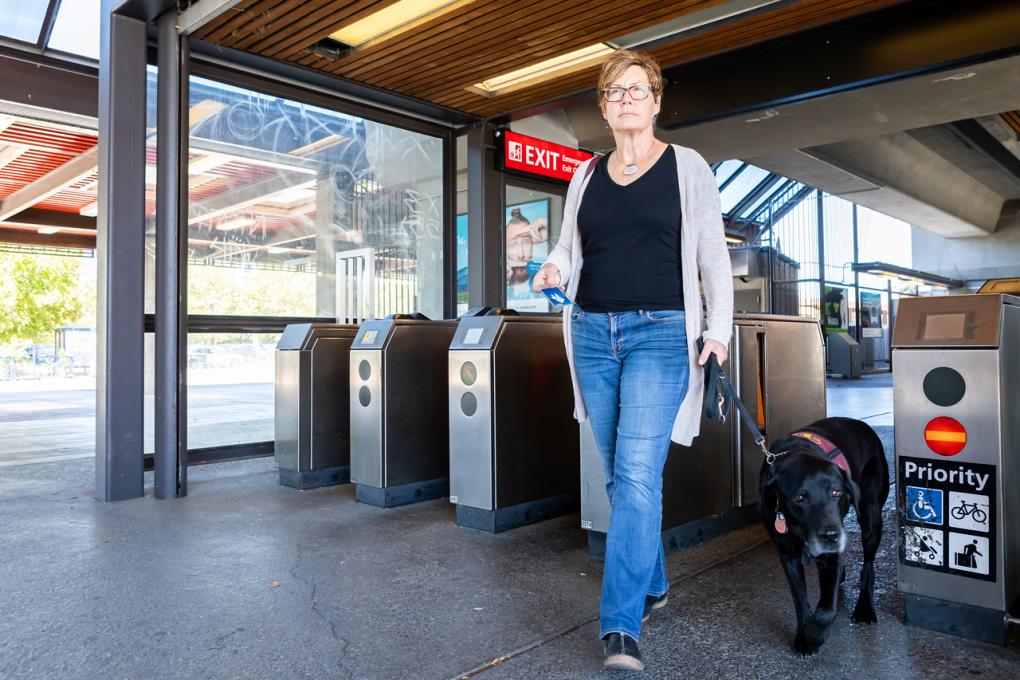
Kathleen Fraser and Handsome Ransom walk through the fare gates at Concord Station.
Most importantly, Fraser asks that you follow BART’s pet policy. Pets are allowed on BART, but they must be properly secured in an enclosed carrier manufactured for pet transportation. In turn, that carrier must be kept off the seats and cleared from the aisle (keep service animals off the seats and out of the aisles, too). Pets on leashes are prohibited.
If these policies are not followed, it puts people with disabilities in danger, as well as their fellow passengers. Bringing your pet on BART without a carrier is inviting interactions with potentially life-threatening consequences, whether it’s Ransom failing to alert Fraser of a blood sugar crash or a poorly behaved dog biting a passenger. A person found to be in violation of BART’s pet policy could be issued a citation and/or ejected from the system.
So far, Fraser hasn’t had any problems on BART, but that doesn’t mean she’s not constantly calculating what could happen when she steps on a BART train or anywhere out in public for that matter.
“If you bring your dog on BART and it behaves badly, people remember that bad experience. Then, when I get on BART with my service dog, they take it out on me,” she said. “It makes everything harder.”
Added Scher: “Follow the rules, and if you won’t do it for humans, do it for the service dogs."
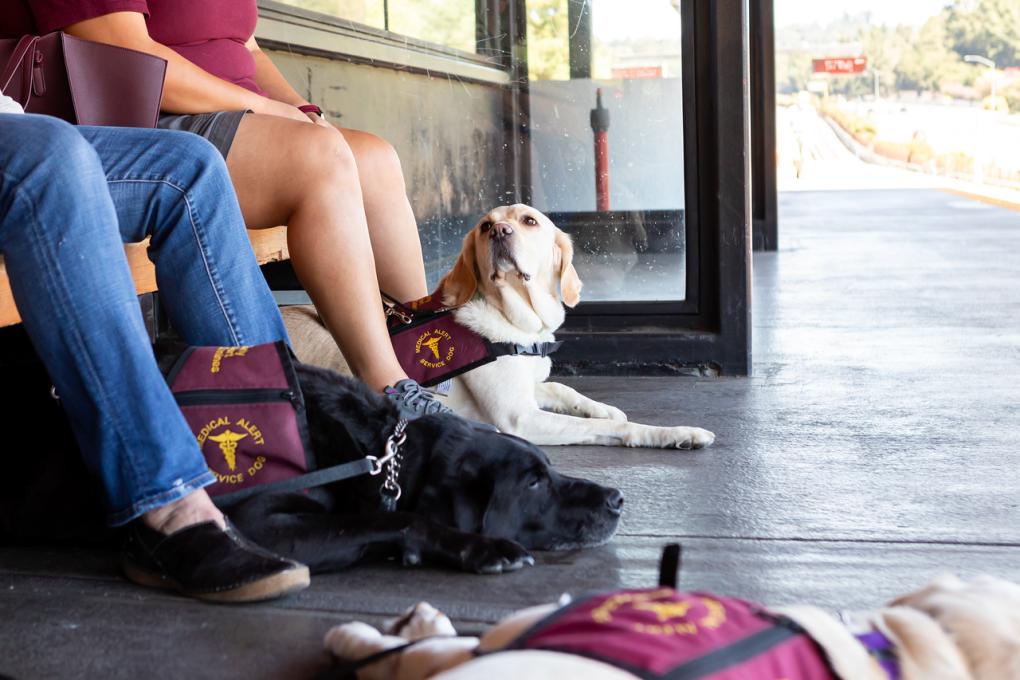
Service dogs reposing on the platform as they wait for a train at Concord Station.
The DOs and DONT’s of Pets on BART
DO bring your non-service animal on BART in an enclosed carrier made for transporting pets. This includes not just trains, but stations as well.
DON’T put the carrier on a seat or in the aisle and keep your service animal off the seats and out of the walkways.
DO be considerate of fellow patrons who may have allergies or fears around certain animals.
DON’T bring a leashed pet onboard (with the exception of trained service animals). Service dogs are allowed off leash if their owners are unable to hold a leash and the animal is under voice command of their owner.
DO remember that not all disabilities are as visible as others.
DON’T pet a service dog, offer it a treat, or distract it in other ways. Try not to acknowledge the animal at all (we know it’s hard).
DO be aware that Station Agents can advise owners that their service animals may not enter a station if the animal is behaving in a way that may threaten other passengers.
DON’T forget that BART Police may issue a citation and/or eject a person from BART if they are found to be in violation of BART’s pet rules.
DO remove all food and trash from trains and deposit it in station receptacles to ensure service animals like Ransom don’t get distracted.
DON’T ask a person what disability they have that enables them to have a service animal. Stick to these two questions: “Is this a service animal?” and “Is this animal working for you?”
DO consider giving up your seat to a person with a service animal to make things easier for them.
DON’T take service dogs on escalators, which could potentially pinch their paws. We recommend using the stairs or elevators. (This is a BART recommendation; California law does allow service dogs on escalators.)
DO be aware that service dogs in training may accompany their disabled owners or authorized trainers on BART. No service animals in training, other than dogs, are allowed on BART on leash or harness.
DON’T bring an emotional support pet on BART unless it is in an enclosed carrier. Emotional support pets are not service animals, per the ADA.
DO reach out to BART’s Customer Access Department, which can arrange free BART rides for those training service animals on the system.